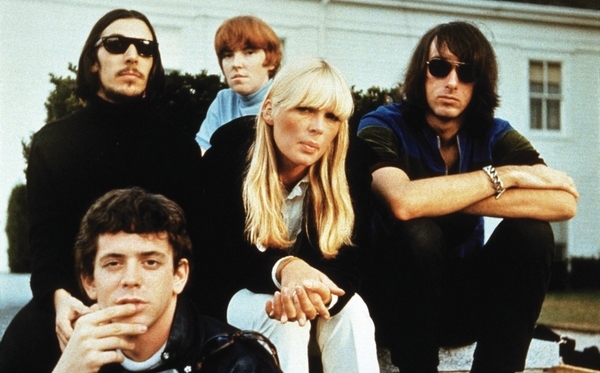The Velvet Underground & Nico was like nothing else. The band’s junk-addled principal songwriter, Lou Reed, had refined his craft as a pop songwriter at Pickwick Records; Welsh-born, classically trained viola player John Cale brought an avant-garde sensibility from his tenure working with Aaron Copland, John Cage and Le Mont Young; Sterling Morrison’s guitar playing added a touch of blues, while Maureen ‘Mo’ Tucker’s minimalist drumming style was punk rock before the concept existed. Upon Warhol’s suggestion, Nordic chanteuse Nico also joined the band. Her tenure was ultimately short-lived, but her icy vocals defined tracks such as Femme Fatale, I’ll Be Your Mirror and All Tomorrow’s Parties.
Commercially, popular lore would have us believe the album sank without a trace: British musician Brian Eno is said to have claimed that only 300 people bought the album but every one of them started a band. But in his book White Light/White Heat, musicologist Richie Unterberger calculated that the debut album sold close to 60,000 copies in the ’60s. “That’s not such a bad showing for an underground album,” says Chris Hollow, bass player in the Sand Pebbles, and a fan of the The Velvet Underground since a former girlfriend gave him copies of the second and third Velvet Underground records.
Spoils guitarist and singer Sean Simmons remembers being given a cassette copy of The Velvet Underground’s first record by a high school teacher. “I’d started playing guitar and was listening to certain types of music,” says Simmons. “I think he’d worked out that I was gravitating toward the roots of rock’n’roll rather than the music of the day. He dubbed me a cassette that had The Velvet Underground & Nico on one side, and on the other, Television’s Marquee Moon. I’ve been hooked ever since.”
Simmons concedes that his appreciation of the dark lyrical themes didn’t come until later. Initially, it was the Velvets’ unique musical style that grabbed his attention. “While those songs are pretty simple, chord-wise, with both that first album and the second album, when the band was really pumping, there are all these really weird frequencies that aren’t really apparent when you first listen to it,” he says.
For Hollow, it was the deceptive simplicity of the music that was most intriguing. “I loved the romance and the sadness and the intelligence of the lyrics,” he says. “But most of all, I loved how the band sounded. Super quiet or poppy or totally abandoned, it sounded amazing to me. The sound was full of possibilities. To my ears they were always only playing one chord. Turns out, they weren’t, but that’s what I wanted to do – boil things down to one chord and come up with ways to make it move.”
The artistic and platonic tension between Reed and Cale was central to the power of The Velvet Underground. “Lou was writing about stuff that was all around him,” Simmons says. “Cale’s influence was more experimental – he brought in drones, got them to start de-tuning instruments, he did whacky stuff like putting mandolin strings on his viola, mixed up all the tunings. Lou was writing the melodies, but Cale was bringing all these atmospherics.”
Hollow also pays tribute to Tucker and Morrison’s oft-neglected contributions to the band. “It helped that Moe Tucker’s limitations were her strength,” he says. “But out of all the Velvets, Sterling Morrison is the one I most wanted to meet. Apparently he was great company, an incredible storyteller. If you’re ever stuck for ideas on a song, it’s always good to ask, ‘What would Sterling Morrison do?’ I’m even starting to come ‘round to his moustache.”
On the subject of Maureen Tucker – most recently seen publicly stating her support for the conservative Tea Party in the US – Hollow says Sand Pebbles drummer Wes Holland bought a toy from her eBay site, just so he could make contact with her – now, that’s dedication to the cause.
By the time White Light/White Heat came out in 1968, tensions within the group had began to mount. Cale was kicked out in 1969, while Reed himself left in 1970, leaving Doug Yule (who’d replaced Cale) to assume lead vocal duties. Morrison left in 1971, and Tucker also briefly left to have a baby, before returning for the band’s oft-maligned final album, Squeeze. By 1972 the Velvet Underground was no more, but their influence was already significant.
On Saturday August 22, The Spoils and the recently reformed Sand Pebbles take to the stage at the Flying Saucer Club to celebrate The Velvet Underground legacy. The Spoils will play The Velvet Underground & Nico, while the Sand Pebbles take on White Light/White Heat. For The Spoils it’s a reprise of their performance at Pure Pop Records last year; for the recently reformed Sand Pebbles, it’s an opportunity to choose between the countless versions of Velvets opus Sister Ray. “I paid $45 at Greville for the Sweet Sister Ray bootleg with John Cale from La Cave, 1968. I have to like that one,” Hollow laughs.
BY PATRICK EMERY







